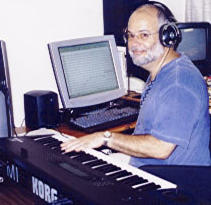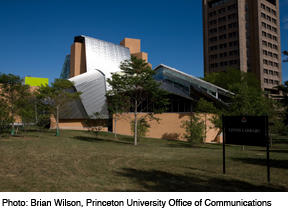The Gehry on Ivy Lane
Panelists critique the Lewis Library
Most students seem to like it. Most alumni seem to hate it. And the faculty? A panel of four experts and "interested semi-amateurs" gave the Frank Gehry-designed Lewis Library mixed reviews.
The four panelists and moderator Gideon Rosen *92, philosophy professor and chairman of the Humanities Council, which sponsored the event, spoke Nov. 19, one day before the dedication of the new science library at Washington Road and Ivy Lane.
Architecture dean Stanley Allen *88 was the most sympathetic. He said the building combines Gehry's "exuberant forms" with "low-tech" details that bring to mind the architect's early work. He gave Gehry points for "making the best of a bad situation" on a difficult and tight site, and defended him after a questioner asked about the "environmental message" sent by a building with so much glass and open space.
Esther da Costa Meyer, associate professor of art and archaeology, took pains to be diplomatic. First, she lauded some of the "beautiful interior spaces," including the reading room known as the Treehouse because its users have a view over the tops of trees. She continued: "That said, this is the most exasperating building to find your way around in. ... Once you get to the Treehouse, there is this sense of catharsis - but it's short-lived, because you realize you're going to have to find your way out again!"
William Gleason, associate professor of English, studies how American writers represent architecture and buildings, including libraries. He considered the message of the library's design, which provides for books in the basement while the upper floors are used for reading, computer use, and "social networking." Gleason called that approach disorienting but efficient, and noted the disconnect between scientists and humanists on such matters. As a member of a committee exploring the renovation of Firestone Library, Gleason heard scientists ask if they needed any books in the library. "The humanists were horrified," he said.
The strongest criticism of the Lewis Library came from the panel's Hal Foster ’77, a professor of art and archaeology who has questioned Gehry's work in the past. Foster began with a rather backhanded compliment: "As far as Gehry goes, it's a good building," he said, before launching into a critique of its "dead spaces," "programmatic confusion," and other shortcomings. Nor did Foster think highly of the Princeton's other massive construction project: the collegiate gothic Whitman College, completed in 2007: "It's said they complement each other - so two wrongs make a right."
And what of the "The Hedgehog and the Fox," the Richard Serra sculpture that now stands right outside the library's door? Before the library was built, people who walked through the large sculpture would exit onto a wedge of grass; now, with little warning, they come right up against Gehry's building. The building "really is a disservice to Serra," said da Costa Meyer, who suggested that the $1 million sculpture is now "shoehorned into a back lot." On the sculpture's sad fate, the panelists all seemed to agree. By Marilyn Marks *86
Tigers show their stripes at 'The Game'
In his Nov. 21 column, David Brooks of The New York Times submitted -- apropos of the emerging Ivy League-heaviness of President-elect Barack Obama's projected cabinet -- that, "If a foreign enemy attacks the United States during the Harvard-Yale game any time over the next four years, we're screwed."

Princetonians might have been justified in taking issue with Brooks' statement ... if they weren't likely to be at said game, too.
Nov. 22 brought the 125th football face-off between Harvard and Yale. Ho-hum -- n'est-ce pas? And yet "The Game" in fact served as an impetus for a rallying of Princetonians from Boston and beyond. Some alumni spent the better part of November planning pub crawls, tailgates, pre-parties and post-parties, negotiating rides from New York, buying plane tickets from D.C., and designing T-shirts. The theme? "You can stop arguing... you both suck."
Admittedly, this reporter was able to locate scores of freewheeling Tigers but no centralized, official unofficial Princeton tailgate in Saturday's sea of crimson and blue. Nevertheless, the benefit of being so unequivocally above the fray -- particularly when, with the wind-chill factor, the midday temperature in Boston was 15 degrees Fahrenheit -- was having the option to simply cancel plans to stand around a parking space and move the party indoors to reunite with friends and show off our new T-shirts, above, at John Harvard's Brew House. For the record, Harvard won, 10-0. By Rachel L. Axelbank ’06
Senior Thesis Spotlight: Getting 'Lost'
Mayday! Mayday! Oceanic Flight 815 is down.
Cut to scene walking along the beach. Fast-forward through survivors arguing by the scene of the crash.
Adrian Diaz ’09 has been turning a careful eye to her television as she examines the narrative structure of ABC's Emmy- and Golden-Globe-winning series Lost for her senior thesis.
Inspired by a lecture given by associate professor Jeff Dolven on Edmund Spenser's The Faerie Queene, Diaz was prompted to study what she saw as a similar interplay between memory, flashbacks, flash-forwards, and storytelling in the popular TV drama. "In Lost, the way things happen is different from the way it's told," she said.
Diaz has been intrigued by the way memory, knowledge, ritual, and group hierarchy have played out in the series. In her work, she has isolated a taxonomy of knowledge that shows how the characters use scientific, rational, and religious knowledge along with gossip to control others. Dr. Juliet Burke, a fertility doctor recruited to the island, for example, is manipulated in such a way that the leader of The Others, Ben, gains control over her expertise. Diaz also anticipates that the process of coercion within the two rival island groups, The Others and the Oceanic Six, can be related back to secret societies.
"The whole show is a process of revealing a secret," Diaz said. "The characters are lost on the island and the audience is also lost in an attempt to figure out what is going on."
The hardest part of her project may be bringing it to an end, since the show itself will still have a sixth season after the senior thesis is submitted. With a focus on seasons one through four, Diaz said, her thesis will inevitably mention the apocalyptic motifs already present in the show.
"I think I will focus on analyzing how knowing an ending is coming affects how we think of the show," she said. By Julia Osellame ’09
An opera, born in a garage
On a hot summer day five years ago, composer Mark Zuckerman *76 was puttering in his garage and spotted his neighbor, poet and writer David Herrstrom, across the street. Zuckerman, who has written choral music, chamber music, and for orchestra, wanted to compose an opera. He asked his neighbor if he would write the libretto. Neither of them had ever tackled an opera, and although they had been friends in the small artistic community of Roosevelt, N.J., for about 30 years, they had never collaborated on any projects. Herrstrom was up for the challenge. "I guess we both felt life was short and why not go for broke," said Zuckerman. "We knew this wasn't going to be a short-term thing and were both looking forward to spending years together on this."

The two men have worked on their opera, The Outlaw and the King, since 2003. Act II will premiere at the Nicholas Music Center at Rutgers University in New Brunswick, N.J., Dec. 1, at 8 p.m. (Act I premiered two years ago, also at Rutgers.) The opera is based on the biblical story of King Saul; David, the warrior and Saul's son-in-law; and Saul's son Prince Jonathan. The cast for Act II is comprised of four male characters and a trio of women portraying the voice of God. The opera is scored for woodwind quintet, harp, and percussion.
Herrstrom chose the story -- a tragic tale that explores how David's growing love of himself as the chosen one leads to the destruction of his adopted father and brother -- and recruited neighbors to stage a dramatic reading in Roosevelt's borough hall in 2005. Roosevelt, built during the New Deal as a utopian cooperative for immigrant Jewish garment workers and farmers and their families, became an artists' haven, home to painters, sculptors, playwrights, poets, and composers. Living in such an artistic community, said Zuckerman, who was a N.J. State Council on the Arts Fellowship Recipient in 2004, helps feed his creative juices. "Almost the entire town gets involved with artistic goings-on in one way or another," he said. By Katherine Federici Greenwood
Above, composer Mark Zuckerman *76 at work. (Photo courtesy Mark Zuckerman *76)













No responses yet